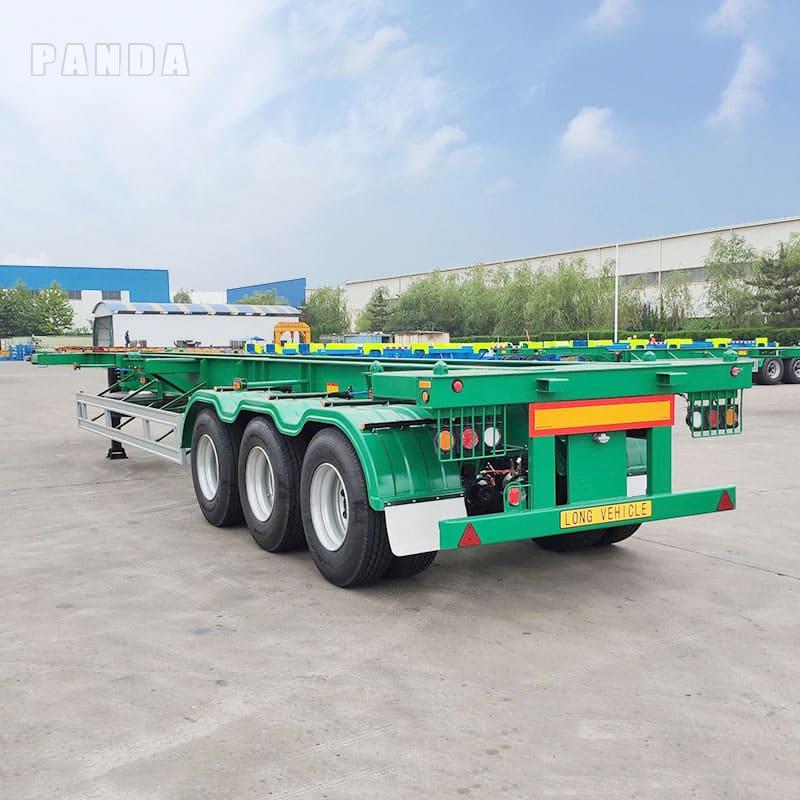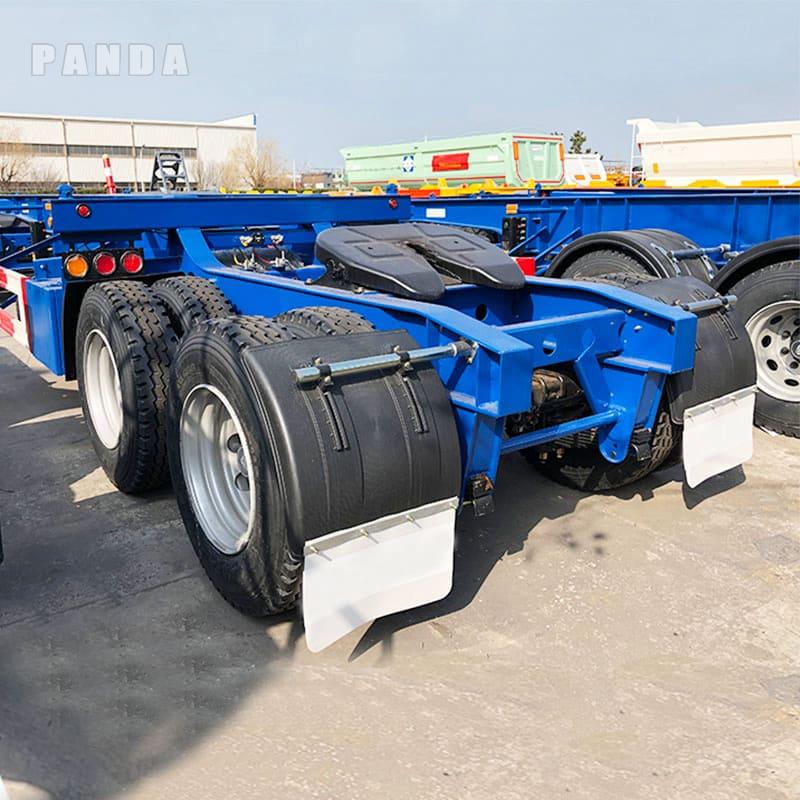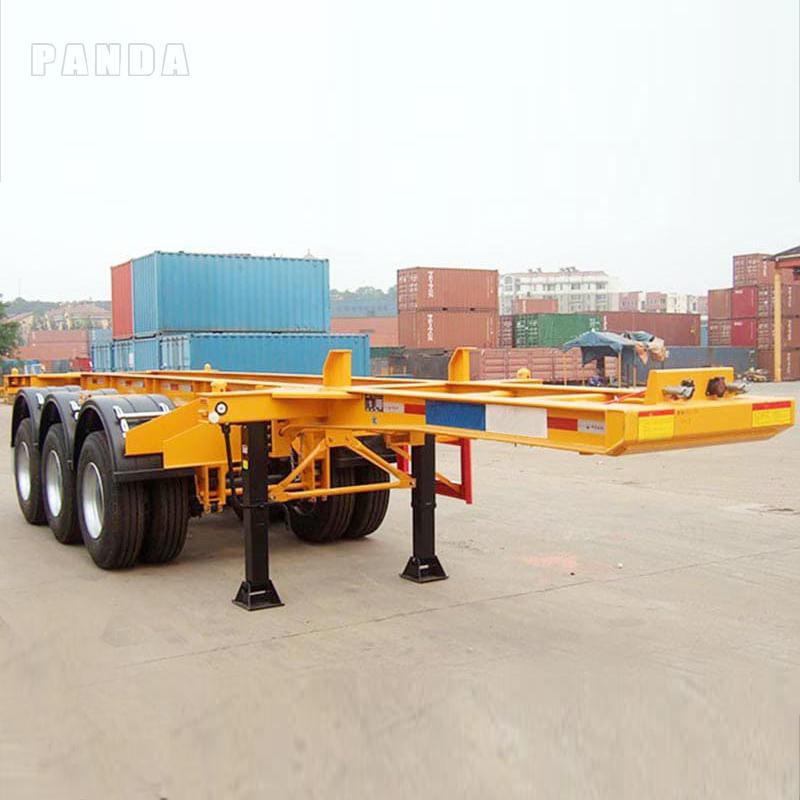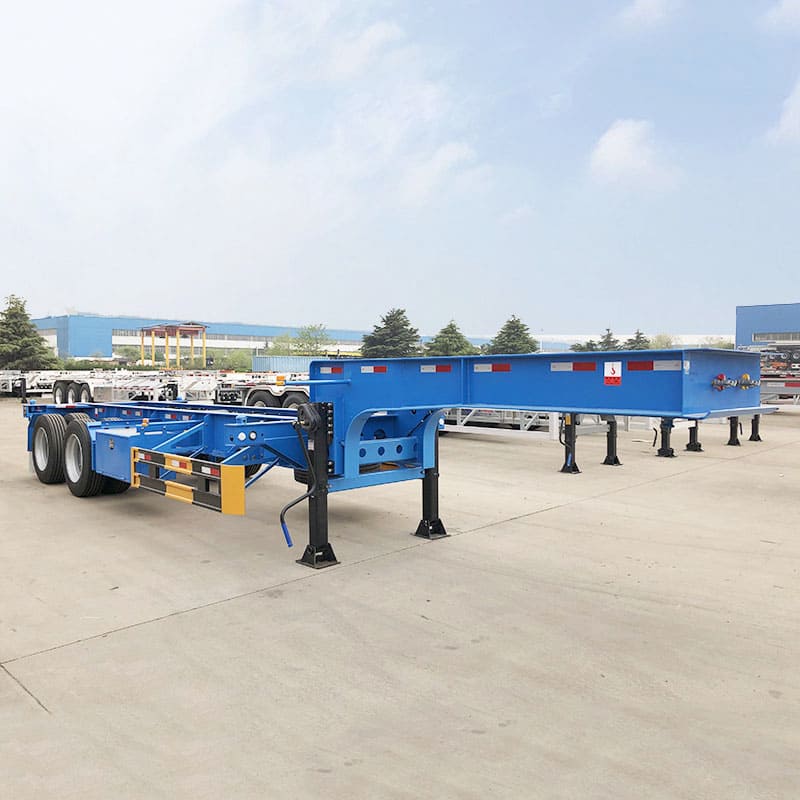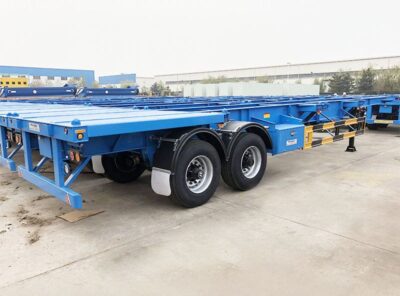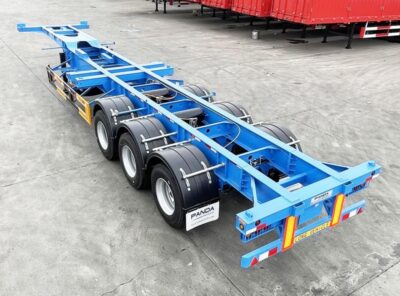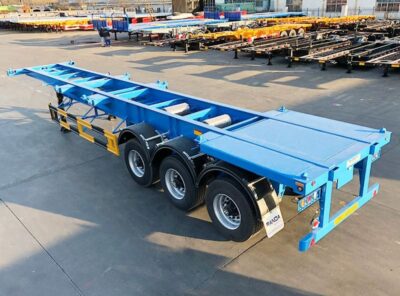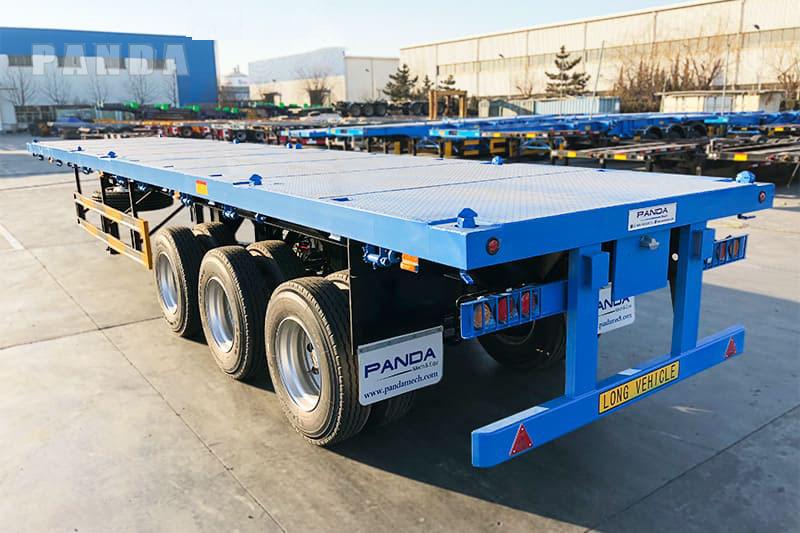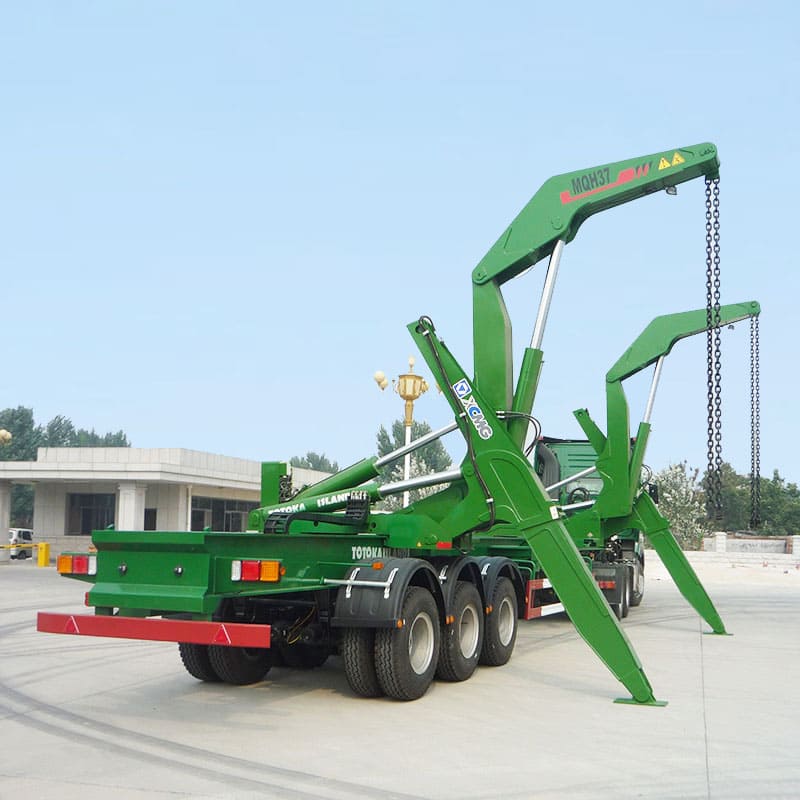The skeletal trailer is used to transport containers. Many friends are unfamiliar with skeletal trailers and often ask me about them, so I wrote an article to explain what a skeletal trailer is.
As a skeletal trailer manufacturer, Panda Mech, we have more than 20 years of experience. I am Zac. I will explain it to you in detail.

What is the skeletal trailer?
Skeletal trailers are used to transport containers, including 20ft, 40ft, 45ft, and ISO intermodal sizes. Equipped with 4 to 12 twist locks to secure containers of various sizes and configurations (e.g., 1x 40-foot or 2x 20-foot). It is also known as a skeleton trailer, skel trailer, or container chassis.
Where skeletal trailers are commonly used
- Ports and Terminals: Panda Mech skeletal trailers are widely used in seaports and container terminals to transport 20ft, 30ft, 40ft, 45ft, and ISO intermodal containers between ships, cranes, and storage areas.
- Logistics and Freight Yards: These trailers are essential in logistics hubs for moving containers to and from warehouses, distribution centers, or intermodal transfer points.
- Construction Sites: Panda Mech trailers transport construction materials or equipment in containers, with some models adapted for timber haulage using timber bunks.
- Industrial Facilities: Used in factories or industrial zones to move heavy machinery, oversized cargo, or bulk materials in containers, often with specialized configurations like tipper or sideloader setups.
- Rail Intermodal Terminals: Employed to transfer containers between trains and trucks, supporting efficient intermodal logistics operations.
How does the skeletal trailer work?
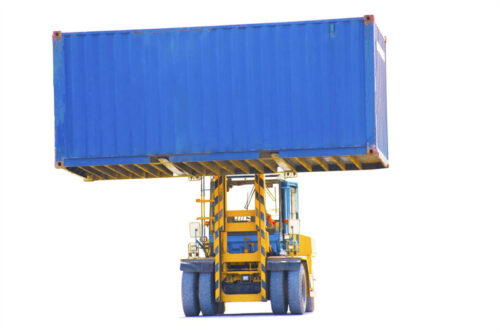
How to load?
- Check Chassis: Before I start, I inspect my Panda Mech trailer. I will make sure the frame, twist locks, axles, suspension, and landing gear are in good shape. I also check the load capacity on the specification plate to ensure it matches the container.
- Confirm Container Size: I will verify that the container (like 20-foot or 40-foot) fits my Panda Mech chassis. The twist lock positions need to line up perfectly with the container’s corners.
- Position Chassis: I will park my Panda Mech trailer on a flat surface. I engage the parking brakes and lower the landing gear if the tractor is not attached. This keeps everything stable.
- Choose Right Equipment: To lift the container, you can use a crane, forklift, reach stacker, straddle carrier, or a Panda Mech sideloader. If I’m using a sideloader, I make sure I’m trained to operate it safely.
- Align Container: I lift the container and line up its corner castings with the twist locks on my Panda Mech chassis. If my trailer has container guides, I use them to position the container perfectly. I also centred the container to balance the weight.
- Lower and Lock Container: I will carefully lower the container onto my Panda Mech chassis. Then, I will secure it with four twist locks—one at each corner. I double-check that all locks are tight and secure.
- Check Weight and Balance: I will make sure the total weight follows axle weight limits and regulations. With my Panda Mech trailer, I adjust the container position if it’s a sliding bogie model to avoid any rollover risks.
- Do a Final Safety Check: I will walk around my Panda Mech chassis to confirm the container is secure. I check the twist locks, ensure the load won’t shift, and verify clearance for the road. I also make sure all paperwork is correct.

How to unload?
- Position and stabilize Chassis: Park the Panda Mech trailer on a flat, stable surface. Engage the parking brakes and lower the landing gear if the tractor is detached to ensure stability.
- Select Appropriate Unloading Equipment: Choose suitable equipment, such as a crane, forklift, reach stacker, straddle carrier, or a Panda Mech sideloader (with proper training).
- Release Twist Locks: Unlock the four twist locks securing the container to the Panda Mech chassis, ensuring all are fully disengaged.
- Lift Container: Use the selected equipment to carefully lift the container, ensuring it clears the chassis without shifting or tilting.
- Place Container: Move the container to its designated location (e.g., dock, storage area, or another vehicle) and lower it gently.
Specification
| Dimension | 8500/12500*2500*1550mm |
| Weight | ≥6500Kg |
| Main Beam | “I” Section 500mm height Q345/T700 material |
| Twist-Lock | 4/8 set ISO Standard |
| Suspension | Mechanical / Air |
| Axle | 2/3 axles, BPW/FUWA brand |
| Rim | 8/12 pieces 9.0-22.5 |
| Tire | 8/12 pieces 12R22.5 Bridgestone/Triangle/Linglong etc |
| Brake Valve | WABCO |
| Kingpin | 2″(50mm)/3.5″(90mm) JOST Bolting Type |
Skeletal trailer for sale
Skeletal trailer feature
- Lightweight Design: Panda Mech skeletal trailers weigh as little as 6,000 kg, using high-tensile steel for maximum payload and fuel efficiency.
- Versatile Twist Locks: Equipped with 4 to 12 twist locks to securely hold containers of various sizes (20ft, 30ft, 40ft, 45ft, or ISO intermodal).
- Multiple Axle Options: Available with 1 to 4 axles, single or dual wheels, and disc or drum brakes to suit different load needs.
- Durable Construction: Built with strong I-beam frames and air suspension for a smooth ride and long-lasting performance.
Skeletal trailer main structure
- I-Beam Main Frame: Two strong I-beams, made of carbon steel (Q345B), run the length of the chassis to support heavy loads, with a standard height of 500mm (14mm top flange, 6mm web plate, 16mm bottom flange).
- Kingpin Assembly: A U-shaped structure welded to connect the trailer to the tractor, available with Jost 50# (2-inch) or 90# (3.5-inch) kingpins for secure attachment.
- Suspension Equalizer: Balanced leaf spring or air suspension system with a rotating arm to ensure stable driving and equal load distribution across axles.
- Cross Members: Includes front/back cross members (carbon steel box beam or #25 channel steel) and middle cross members (140mm, 160mm, or 180mm height) to support twist locks and connect I-beams.
- Landing Gear: Mechanical landing gear (Jost or Fuwa brands) with one- or two-speed operation to support the trailer when detached from the tractor.

20ft container chassis trailer
How to Choose a Skeletal Trailer Manufacturer
Selecting the right skeletal trailer manufacturer, such as Panda Mech, involves evaluating key factors to ensure the trailer meets your business needs and offers long-term reliability. Here’s a simple list to guide your decision:
- Compare Support and Warranty: Look for manufacturers with strong after-sales support. Panda Mech provides warranties, maintenance solutions, and responsive customer service to ensure long-term reliability and timely delivery.
- Check Reputation and Experience: Research manufacturers with a strong track record. Panda Mech, with over 20 years of experience and ISO 9001 certification, is known for durable, high-quality trailers.
- Evaluate Customization Options: Choose a manufacturer that offers tailored solutions. Panda Mech provides customizable trailers (e.g., 20ft, 40ft, or tipper configurations) to match specific cargo, road conditions, and operational needs like sideloaders or sliding chassis.
- Assess Build Quality and Materials: Ensure the manufacturer uses high-strength steel and reliable components (e.g., Jost or Fuwa landing gear, BPW axles). Panda Mech trailers feature robust I-beam frames and shot-blasted surfaces for durability and low maintenance.
- Verify Compliance with Regulations: Confirm the manufacturer’s trailers meet local laws (e.g., weight limits, safety standards). Panda Mech offers professional advice to adjust trailers for specific road conditions and regulatory requirements.
Contact Panda Mech
If you still have any questions about the skeletal trailer, you are welcome to contact us at any time, and we will reply to you within 1 hour.




